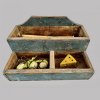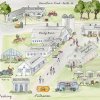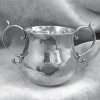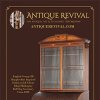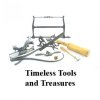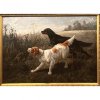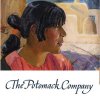Big Crowds at Antiques in Manchester
August 7th, 2013
|
James William Lowery of Baldwinsville, New York, featured this over 7' long hooked rug that was inspired by Edward Hicks but oddly reminiscent of the jungle paintings of Henri Rousseau. Lowery called this “a folk art masterpiece.” It dated to the 1860’s, Lowery said, and was found in Scriba, New York. It is now archival-level preserved and priced at $125,000.
Tom Clark of Francestown, New Hampshire, and Bruce Emond of the Village Braider, Plymouth, Massachusetts, always put together an interesting booth. On the wall are sculptures made of railroad spikes by an African-American man. His descendants sold them as a group to Clark. Gemini Antiques, Ltd. spotted them during setup and bought the group.
This circa 1825 armoire decorated with sponged sgraffito and putty work paint is 65½" high x 52½" wide. Mark and Marjorie Allen of Gilford, New Hampshire, asked $8900 for it. The circa 1750 Dutch garniture was $15,000.
This was the “first time out” for this circa 1925 decoy carved by New Brunswick maker Amateur “Mat” Savoie (1896-1983), said Steven S. Powers of Brooklyn, New York. The price was $4800.
Offered by Don Olson of Rochester, New York, was a New England blanket chest, ex-Bertram K. and Nina Fletcher Little collection, that was $22,500; the Worcester, Massachusetts, decorated dome-top box, circa 1825, approximately 16" long, was $18,900; and the anniversary tin basket filled with velvet fruit belonged to Barry Cohen and is shown in the 1990 catalog of his collection by David Schorsch and America Hurrah on pages 14 and 15; it was $38,500.
White-painted furniture is often associated with bridal gifts or ladies’ furniture. Dover House Antiques, Louisville, Kentucky, showed these pieces to great advantage against a dark green wall. The Federal mirror with carved cornucopia is 33" tall and $595. The circa 1825 Maine dressing table with shell-painted decoration is 42" tall to the top of the splash and 36 3/8" wide and $4950.
David Good of Camden, Ohio and Samuel Forsythe of Columbus, Ohio, offered the circa 1710 turned birch chair from Quebec for $24,000.
Daniel and Karen Olson of Newburgh, New York, showed this unusual oval portrait on mattress ticking in a frame that was made for it. It’s about 39" high overall and had an under-$3000 price tag. The subject is seated in a Classical chair and has what is perhaps a sketchbook in her hand. The painting dates to around 1825-35. |
Manchester, New Hampshire
“It can be done!” Several people who wanted to report their findings sought us out among the throngs on the floor of the packed JFK Memorial Coliseum at the Antiques in Manchester show, which was held August 7 and 8. Collector Richard Michelman of Westminster, Vermont, was the first. “We stood in line for the opening of the Midweek show and were in by shortly after eight, spent well over two hours there, had lunch, drove here, and were in line for the opening at noon,” Michelman reported.
The “it” that could be accomplished was the following: be at the opening of the Midweek Antiques Show in Concord; examine, with some degree of thoroughness, the material that exhibitors brought; leave Midweek and drive 15 miles to Manchester; and be in line when Antiques in Manchester opens.
A letter from Oshkosh, Wisconsin, collector Baron Perlman, printed in our June issue under the title“Collector’s Point of View,” suggested that the collectors at issue were poorly served by the announced scheduling of the two shows opening on Wednesday within a three-hour span. Perlman’s conclusion was that “You are almost forced to choose one show over the other.”
That letter led to an exchange of missives from the two show promoters involved, Frank Gaglio of Barn Star Productions for the Midweek Antiques Show and Karen DiSaia of DiSaia Management for Antiques in Manchester (AIM), also known as the Collector’s Fair.
Gaglio moved his opening hour back to 8 a.m., “In order to give Midweek exhibitors a decent shot [literally three hours] to do business…making it even more difficult and inconvenient for collectors….”
DiSaia replied that many of her dealers would have liked to open even earlier, at 10 a.m., but, “I held the line at noon, giving everyone plenty of time to shop Midweek before coming to AIM.”
Gaglio responded with a letter in the August issue that stated DiSaia’s claim that at one point an agreement had existed between them that Midweek would open at 11 a.m. “was unfounded.”
It’s obvious that an air of animosity exists between the two show promoters, but did it have an effect on attendance at either venue?
Richard Michelman stood in line for both shows and said he was not affected by the opening hours. A New York state dealer who did the same reported he saw no effects on attendance at either, although he did note that Gaglio provided a free lunch for attendees, which was extremely popular.
“I think Frank put on the free feed because he knew antiques people will stand in line for anything free. He was hoping to keep them there long enough to keep down attendance at the Collector’s Fair,” said the dealer, with a broad smile suggesting the comment was made in jest.
Collector and student of antiques Steve Tushingham of Demarest, New Jersey, said he spent
one and a half hours at the Midweek show and felt he’d seen everything he was interested in. Tushingham was among the first 25 or so in line at Collector’s Fair.
Even Baron Perlman conceded that the distance between Concord and Manchester (15 miles on an interstate highway) and the shows’ hours were not an issue.
Perlman had a twinkle in his eyes and a smile on his face as he noted, “Oh yes, I made it to both shows with no problems, so I apologize to the promoters for suggesting it couldn’t be done. It was an issue that somebody had to raise, though, and I’m glad I wrote the letter. Let’s face it, it doesn’t hurt the Digest’s circulation any to keep readers on their toes with a bit of continuing controversy, does it?”
The JFK Memorial Coliseum was packed during Wednesday’s opening with a mix of exhibitors that included names both well known and not. There was a variety of material on offer, ranging from a folk art hooked rug bearing a nighttime scene highly reminiscent of a Henri Rousseau painting with a $125,000 price tag to a handmade folding knife with a $125 price tag.
Some dealers were buying during setup and pre-opening despite the knowledge that showgoers are beginning to resent what a collector described in a letter to the editor in our August issue as an “infuriating and disheartening” practice.
We happened to walk in on one of those preshow dealer-buys. There was a display of iron railroad spike figure sculptures made by a retired African-American railroad worker, evidently for his own enjoyment, mounted on a wall in a booth at the rear of the coliseum. Francestown, New Hampshire, dealer Tom Clark, sharing a booth with Village Braider dealer Bruce Emond, had just mounted the 25 or so figures on the special plinths he’d constructed for them when one of the Weiss twins spotted them. A discussion followed and the Oldwick, New Jersey-based brothers, known as Gemini Antiques, Ltd., became the new owners. They opted to leave the figures in place in the Clark-Emond booth.
Making preshow purchased merchandise available to admission-paying customers is the best solution we’ve seen to the problem.
So, with the potential controversial parts covered, how well did the Collector’s Fair stack up at its second year in Manchester?
First off, the quality of offerings was extremely high. There may have been a few pieces of show-weary merchandise on the floor here and there, but it was obvious most exhibitors took the time to pick out their best for this DiSaia production.
Pricey? Sure, exhibitors didn’t balk at writing big numbers on price tags. But collectors willingly paid some of those big numbers during the hours we were on the floor.
We covered only this show and the NHADA show this year, so we can’t judge this show against the ones held elsewhere, but our impression was that selling was brisk and consistent (see the caption used with Norman Gronning’s Pennsylvania valuable chest, for example), and the stream of visitors was steady on opening day.
This summer Peter Eaton and Joan Brownstein of Newbury, Massachusetts, left the NHADA show (where Eaton has exhibited for 40 years) to join the AIM lineup. We asked Eaton and Brownstein for their comments about the show.
Eaton replied via e-mail, “I sold a very good small hanging apothecary in old red paint, an unusual folky lodge assemblage, a rare 18th-century family record to a noted Midwestern collector, a birdcage dish-topped tea table to longtime NJ collectors, and a folk candlestand with bird-shaped legs and feet to CT collectors. The Bailey dwarf, or grandmother’s, clock, and my Rhode Island gateleg table sold to collectors from MA. Throw in a few smalls, and it was quite a show!
“Sales aside, we really enjoyed the show. I thought the quality of the material throughout the show was consistently of good quality, that the booths all looked good, and—with only one exception—every dealer I talked with had a great show. Despite the rush at the opening, we had an opportunity to talk with customers throughout the day. Dealers were helpful and friendly, and management was terrific—professional and always available. For a show in only its second year, we thought it was pretty remarkable—and we’re definitely looking forward to participating next year.”
Joan Brownstein, although not having quite as a successful show as Eaton, offered her comments. She sold a portrait miniature on ivory, ceramic items, needlework items, a Ralph Cahoon painting, and document objects from the George Isaacson collection.
For more information, contact Karen DiSaia Management at (860) 908-0076; Web site (www.antiquesinmanchester.com).
Originally published in the October 2013 issue of Maine Antique Digest. © 2013 Maine Antique Digest







